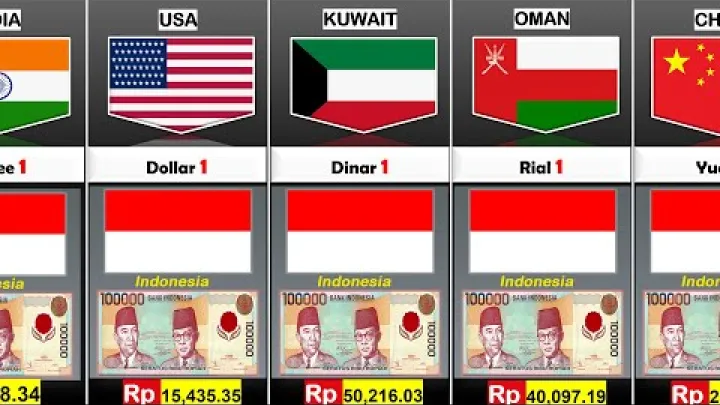Indonesian Rupiah to USD: Essential Guide for International Travelers
The Indonesian rupiah (IDR) is the official currency of Indonesia, Southeast Asia's largest economy and the world's largest archipelago nation. Whether you're planning a beach vacation in Bali, preparing for studies in Jakarta, or engaging in business with Indonesian partners, understanding the relationship between IDR and USD is essential for effective financial planning. This guide provides comprehensive information about the Indonesian rupiah to US dollar exchange rate, historical trends, and practical tips for managing your money in Indonesia.
Understanding the Exchange Rate System
Indonesia operates under a managed float exchange rate system. This means market forces primarily determine the rupiah's value, while Bank Indonesia occasionally intervenes to reduce volatility. As of November 2023, the exchange rate typically fluctuates around 15,500-15,700 IDR to 1 USD, though this changes daily based on market conditions.
For first-time visitors, the high denomination of the rupiah can be initially confusing. You'll commonly encounter large numbers in everyday transactions—a 100,000 IDR note (approximately $6.50 USD) is frequently used for regular purchases.
To check current exchange rates, these reliable sources are recommended:
- Bank Indonesia's official website (bi.go.id) - the most authoritative source
- Financial platforms like XE.com, OANDA, and Bloomberg Markets
- Major international banks' currency conversion tools
Remember that these sources display the interbank or mid-market rate. Actual exchange services typically offer less favorable rates due to their service margins.
Historical Exchange Rate Trends
The IDR-USD exchange rate has experienced significant fluctuations over the decades:
- 1990s Asian Financial Crisis: Before the crisis, the exchange rate was around 2,000 IDR per USD. During the crisis, it plummeted to over 16,000 IDR per USD, losing nearly 80% of its value.
- 2008 Global Financial Crisis: The rupiah weakened from approximately 9,000 to 12,000 IDR per USD as global economic uncertainty affected emerging markets.
- 2013-2015: Another significant depreciation period saw the rupiah fall from 9,700 to around 14,000 IDR per USD, largely due to the US Federal Reserve's policy tightening and falling commodity prices.
- 2018-2020: The currency fluctuated between 13,500-15,000 IDR per USD, responding to global trade tensions and the beginning of the COVID-19 pandemic.
- 2020-2023: The pandemic and subsequent global economic challenges kept the rupiah relatively weak, hovering around 14,000-15,700 IDR per USD.
These historical patterns reveal how Indonesia's currency responds to both domestic economic policies and global economic events.
Practical Currency Conversions
Understanding common conversion amounts helps contextualize the value of the Indonesian rupiah in real-world terms:
- 10,000 IDR ≈ $0.65 USD – This might buy you a simple street food meal like nasi goreng (fried rice) from a warung (small local restaurant)
- 50,000 IDR ≈ $3.25 USD – A typical cost for a short taxi ride in Jakarta or a casual meal
- 100,000 IDR ≈ $6.50 USD – A mid-range restaurant meal or budget accommodation for one night in some areas
- 1,000,000 IDR ≈ $65 USD – A night at a good hotel or a domestic flight between Indonesian islands
- 10,000,000 IDR ≈ $650 USD – Monthly rent for a decent apartment in Jakarta or Surabaya
- 1 billion IDR ≈ $65,000 USD – Significant business transactions or property investments
For travelers planning a budget, these conversions provide practical context. A mid-range traveler in Bali might budget around 750,000-1,500,000 IDR ($50-100 USD) daily for accommodation, meals, and activities.
Several reliable online tools can help with currency conversion, including XE Currency, OANDA Currency Converter, and Google's built-in currency calculator. Many banking apps also offer conversion tools, though they may use slightly different rates.
Cross-Currency Comparisons
The Indonesian rupiah's value varies significantly when compared to other regional and global currencies:
- IDR to Singapore Dollar (SGD): 1 SGD ≈ 11,500 IDR – Singapore's stronger economy generally means a stronger currency, making Singapore significantly more expensive for Indonesian travelers.
- IDR to Australian Dollar (AUD): 1 AUD ≈ 10,300 IDR – Australia is a popular destination for Indonesian students and tourists.
- IDR to Philippine Peso (PHP): 1 PHP ≈ 280 IDR – Both are Southeast Asian currencies, but the PHP has historically been stronger.
- IDR to Malaysian Ringgit (MYR): 1 MYR ≈ 3,300 IDR – Malaysia is an important trading partner for Indonesia.
- IDR to Euro (EUR): 1 EUR ≈ 16,800 IDR – The Euro typically trades at a premium to the USD against the rupiah.
These comparisons are particularly relevant for travelers planning multi-country trips across Southeast Asia, businesses operating across the ASEAN region, and students considering educational options in different countries.
Money Transfer Options
When transferring money between USD and IDR or exchanging currency for travel, you have several options, each with different benefits and drawbacks:
Banking Options:
- Indonesian Banks (BCA, Mandiri, BNI): These offer competitive rates but may charge fixed fees for international transfers. For example, sending $1,000 USD to an Indonesian bank account might incur a $25-40 USD fee plus currency conversion costs.
- International Banks (HSBC, Citibank): These provide convenience and often waive fees for account holders, but their exchange rates may be less favorable, effectively hiding costs in the exchange rate margin.
Digital Platforms:
- Wise (formerly TransferWise): Typically offers better rates than traditional banks, with transparent fee structures. A $1,000 USD transfer might cost around $8-12 USD in fees plus a small exchange rate margin.
- PayPal: Convenient but often expensive for currency conversion, with fees that can reach 4-5% through a combination of transfer fees and exchange rate margins.
Money Transfer Services (Western Union, MoneyGram):
- Convenient for quick transfers, especially to remote areas, but generally more expensive than digital alternatives.
Exchange Rate Considerations:
- Airport exchange counters typically offer the least favorable rates (sometimes 5-10% worse than market rates)
- Money changers in tourist areas (like Kuta in Bali) often provide better rates than airports but still below bank rates
- Local banks generally offer fair rates with proper identification
- ATM withdrawals provide convenience but watch for both your bank's foreign transaction fee (typically 1-3%) and the local ATM fee (around 20,000-50,000 IDR per transaction)
Practical Tips for Travelers
- Notify your bank before traveling to Indonesia to prevent card blocks
- Exchange a small amount before arrival for immediate expenses like airport transportation
- Use ATMs connected to major banks for better security
- Always count your money immediately after exchange and check for counterfeit notes
- Consider a multi-currency travel card to lock in exchange rates before your trip
- Keep smaller denominations handy for small purchases and transportation
- Be cautious of "no fee" currency exchanges, as they often hide costs in poor exchange rates
- In tourist areas, confirm if prices are quoted in IDR or USD before making purchases
Budget Considerations for Different Travelers
Indonesia remains relatively affordable for USD holders, making destinations like Bali, Yogyakarta, and Jakarta attractive to international tourists.
Budget Travelers:
- Can comfortably explore Indonesia for $30-50 USD per day
- Accommodation: Hostels or basic guesthouses ($5-15 USD per night)
- Food: Local warungs and street food ($1-5 USD per meal)
- Transportation: Public buses, shared rides, or motorbike rentals
- Activities: Free beaches, hiking, and cultural sites with occasional paid attractions
Mid-range Travelers:
- Spending $50-100 USD daily offers a comfortable experience
- Accommodation: 3-star hotels or nice private rooms ($20-50 USD per night)
- Food: Mix of local restaurants and some Western options ($5-15 USD per meal)
- Transportation: Private drivers, taxis, or rental cars
- Activities: Guided tours, spa treatments, and cultural experiences
Luxury Travelers:
- Luxury experiences are available at lower prices compared to Western countries
- Accommodation: Five-star hotels often available for $100-200 USD per night
- Food: Fine dining restaurants ($15-50 USD per meal)
- Transportation: Private drivers, luxury car rentals
- Activities: Private tours, yacht charters, exclusive experiences
Cash is still widely used throughout Indonesia, though credit cards are accepted in tourist areas and major cities.
For Students and Business Professionals
For Students:
- International students from Indonesia studying in the US face higher effective costs when the rupiah weakens against the dollar
- American students in Indonesia benefit from strong purchasing power, making study abroad programs financially attractive
- Scholarship values and financial planning should account for potential currency fluctuations over the study period
- Students should consider opening a local bank account for extended stays to avoid foreign transaction fees
- Educational expenses in Indonesia are generally much lower than in Western countries, with quality universities charging a fraction of US tuition
For Business Professionals:
- A weaker rupiah makes Indonesian exports more competitive internationally, benefiting sectors like textiles, agriculture, and manufacturing
- Foreign investors may find attractive opportunities in Indonesia due to favorable exchange rates, particularly in sectors the government has prioritized for development
- Currency volatility can create challenges for long-term business planning, so many companies operating in Indonesia use hedging strategies
- Businesses often manage currency risks through forward contracts or other financial instruments, particularly for large transactions
- Understanding local banking systems and establishing relationships with Indonesian financial institutions is valuable for ongoing business operations
Economic Factors and Future Outlook
Several factors influence the IDR-USD outlook:
Economic Indicators to Watch:
- Indonesia's GDP Growth: Stronger growth typically strengthens the rupiah. Indonesia's economy has been growing at around 5% annually in recent years.
- Inflation Rates: Higher inflation in Indonesia relative to the US generally weakens the rupiah. Indonesia has worked to maintain inflation within its target range of 2-4%.
- Interest Rate Differentials: Bank Indonesia's policy rates versus the US Federal Reserve – wider differentials can attract or repel foreign investment.
- Current Account Balance: Indonesia's trade position impacts currency strength. Commodity exports like palm oil, coal, and metals significantly affect this balance.
- Political Stability: Elections and policy changes can cause short-term volatility in the rupiah.
As of late 2023, economists generally expected the rupiah to remain relatively stable against the USD in the short term, with potential for modest strengthening if Indonesia's economic recovery continues and commodity prices remain favorable. However, any significant changes in US monetary policy could impact this outlook.
Remember that currency forecasts are inherently uncertain, and unexpected global events can rapidly change economic conditions.
Conclusion
Understanding the exchange rate between the Indonesian rupiah and the US dollar is essential for anyone traveling to Indonesia, conducting business there, or planning educational pursuits. While the rupiah has faced challenges against the dollar historically, it provides significant purchasing power for USD holders visiting or investing in Indonesia.
The relationship between these currencies reflects broader economic trends and can significantly impact your travel budget, business operations, or study plans. By staying informed about exchange rates and understanding the factors that influence them, you can make more informed financial decisions and maximize your money's value in Indonesia.
For the most accurate and current information, always check official sources like Bank Indonesia or reputable financial websites before making significant currency exchanges or financial decisions involving the Indonesian rupiah.
Your Nearby Location
Your Favorite
Post content
All posting is Free of charge and registration is Not required.


